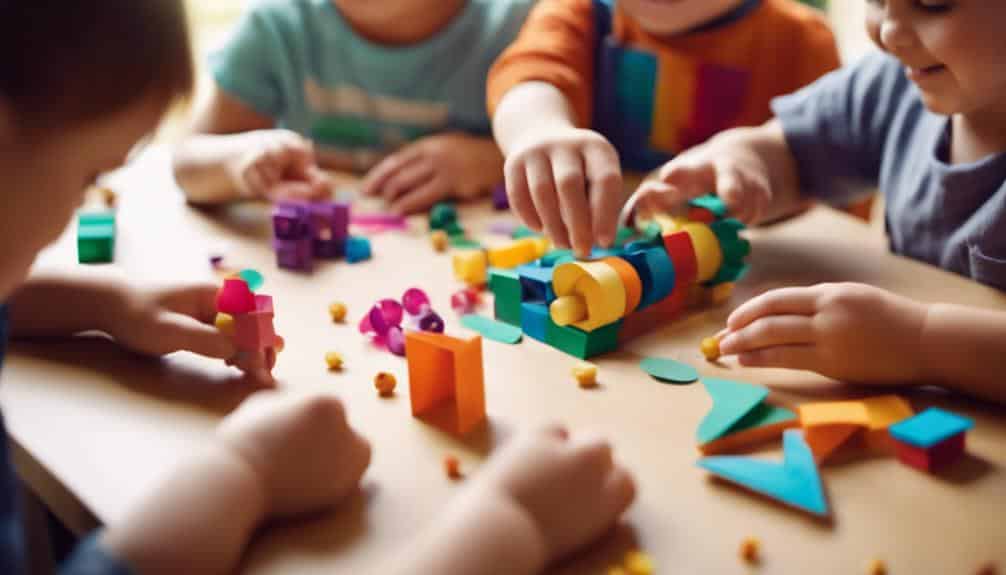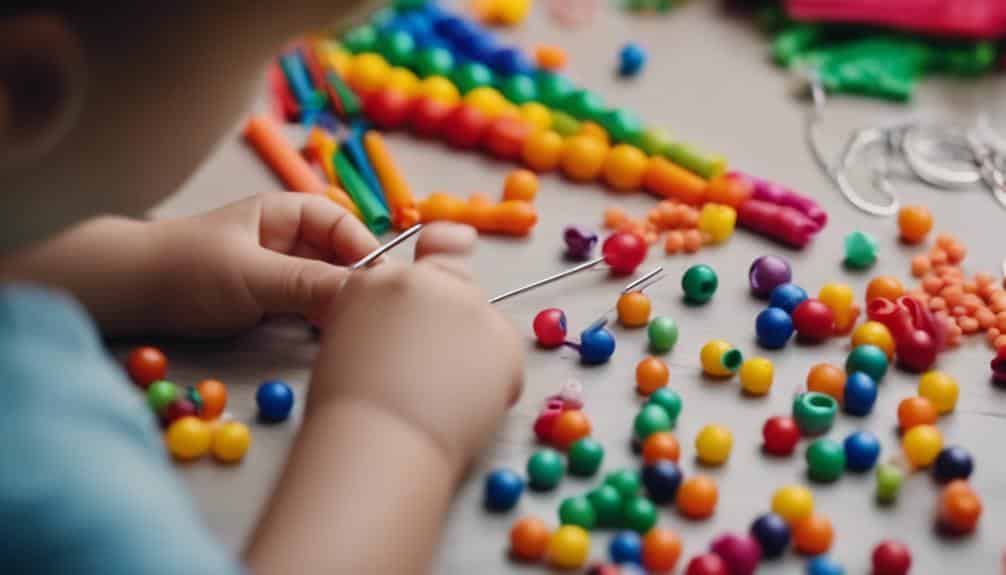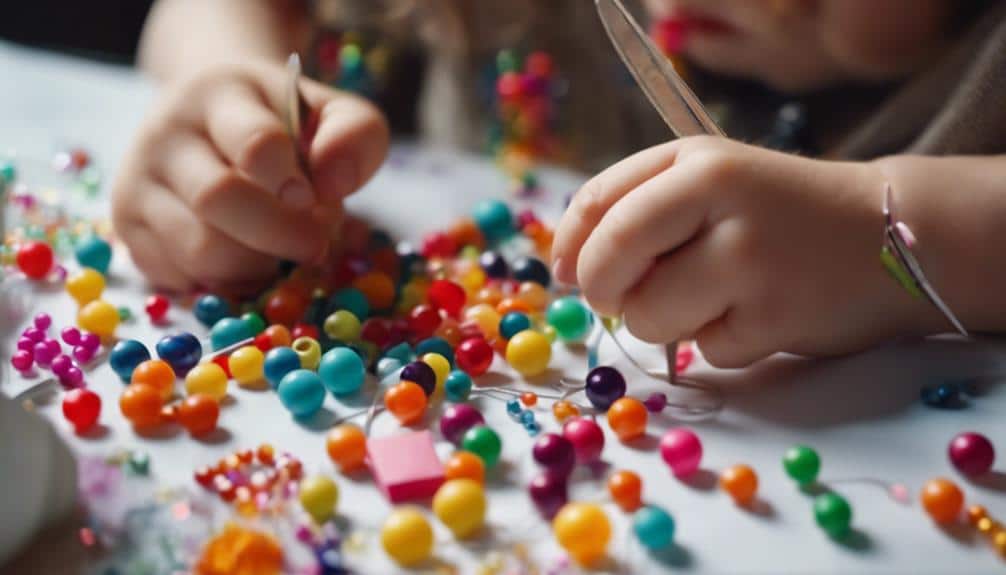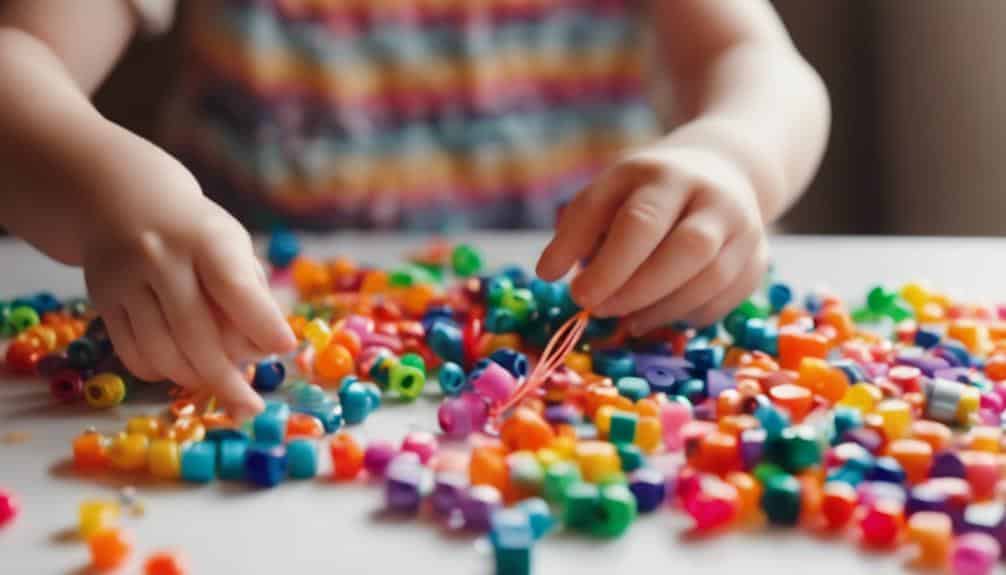Engage your child in daily activities to develop fine motor skills like hand-eye coordination and independence. For toddlers, beneficial tasks include stacking blocks and playing with puzzles. Please encourage them to pick up small objects to improve coordination further.
Preschoolers benefit from activities like sculpting playdough and stringing beads together, which enhance hand strength and agility. Incorporate creative arts, crafts, and sensory play tailored to your child’s preferences. Consistent practice with various tasks lays a strong foundation for future learning and skill mastery. Explore additional strategies with an occupational therapist to support your child’s journey toward acceptable motor skill proficiency.
Key Takeaways
- Provide tools like crayons, scissors, and playdough to enhance hand strength and coordination.
- Engage in activities like stringing beads and puzzles to improve hand-eye coordination and fine motor skills.
- Incorporate sensory play with sand, water, or slime to stimulate tactile awareness and motor control.
- Utilize technology, such as educational apps, to make fine motor skill development engaging and accessible.
- Offer consistent encouragement and create challenges with diverse tasks to foster a supportive environment for skill mastery.
Understanding Fine Motor Skills Essentials
Fine motor skills, the intricate coordination of small muscles in the hands and fingers, are pivotal for children’s development, enabling them to perform essential daily tasks with greater independence and proficiency. These skills include writing, using utensils, and buttoning clothes necessary for a child’s daily life and academic performance. Developing fine motor skills not only aids in accomplishing these activities but also contributes to improved hand-eye coordination and spatial awareness. As children build their fine motor skills, they gain a greater sense of self-c,ce, which is essential for their overall development and success in school settings.
Activities designed to enhance these skills are crucial and should be incorporated into a child’s routine from an early age. However, it’s essential to understand that the progression of fine motor skills varies with each child, requiring patience and encouragement from caregivers and educators. By fostering an environment that supports the development of these skills, children can achieve milestones in their fine motor development, laying the foundation for future academic achievements and everyday self-reliance.
Activities for Toddlers
Engaging toddlers in specific activities that target developing fine motor skills is crucial for their growth and future learning capabilities. Activities for toddlers, such as stacking blocks, playing with puzzles, and using crayons, are foundational in enhancing their fine motor skills. These tasks encourage the precision, hand strength, and hand-eye coordination necessary for more advanced skills later in life.
Encouraging toddlers to pick up small objects with their fingers improves coordination and refines their ability to manipulate items precisely. Activities that involve tearing paper, squeezing playdough, and threading beads are particularly effective in developing hand strength and coordination. These activities challenge toddlers to use their muscles in new ways, strengthening their grip and control.
Moreover, toys that require twisting, turning, and pushing buttons offer an enjoyable way for toddlers to refine their fine motor skills further. Introducing tools like tongs, tweezers, or clothespins can significantly enhance their hand-eye coordination and fine motor control in play scenarios. These activities are not just play but essential steps in building the talent and skills needed for future academic and life skills.
Exercises for Preschoolers

Refining their fine motor skills becomes essential for future academic and daily activities as preschoolers develop. Engaging them in exercises such as playdough sculpting, stringing beads together, and cutting paper shapes enhances their skills and improves hand-eye coordination and muscle strength in a fun, interactive way. These activities, grounded in evidence-based practices, are designed to meet the developmental needs of preschool-aged children, providing a solid foundation for more complex skills.
Playdough Sculpting Fun
Playdough sculpting is a pivotal exercise for preschoolers, aiding in developing hand strength and coordination through the kneading and shaping the material. This form of play is engaging and a cornerstone among fine motor activities, designed to enhance young children’s precision and control over finger movements. Introducing tools like cookie cutters or plastic knives further refines these skills, encouraging preschoolers to explore various textures and shapes, thereby fostering a rich sensory experience alongside creativity.
Through such playful yet purposeful interactions, preschoolers improve their talent and the groundwork for more complex motor skills, making playdough sculpting an indispensable tool in their developmental toolkit.
Stringing Beads Together
Stringing beads together often is a highly effective method for preschoolers to enhance their hand-eye coordination and fine motor skills by precisely manipulating small objects. This engaging activity improves focus and requires preschoolers to use exact finger movements to develop skills and hand muscles. By threading beads onto a string or lace, children also develop bilateral coordination, an essential skill for tasks that require using both hands in a coordinated manner.
Additionally, stringing beads can promote cognitive skills such as pattern recognition and sequencing, making it a multifaceted exercise. It’s a fun, educational way to help your child build exemplary motor prowess, laying a solid foundation for future learning and development.
Cutting Paper Shapes
Engaging preschoolers in cutting paper shapes is vital to greatly enhancing their hand-eye coordination and fine motor skills. It offers a practical approach to developing essential abilities through focused and creative exercises. This activity promotes motor coordination and builds finger strength and control, which are necessary for precise cutting.
They can improve their scissors skills by guiding preschoolers to cut along simple outlines. Additionally, this task fosters creativity and spatial awareness, cornerstones in the holistic development of motor abilities. However, supervision is essential to guarantee safety and correctly execute scissor techniques, safeguarding an environment where learning and skill development can flourish without risk.
Everyday Tasks as Practice

Incorporating everyday tasks into your child’s routine is a practical and effective method for enhancing their fine motor skills. Encouraging activities such as using art supplies for creative projects or guiding them through dressing and undressing can notably improve their dexterity and hand-eye coordination. These tasks support skill development and promote independence in young learners.
Using Art Supplies
Utilizing art supplies, such as crayons, markers, and paintbrushes, for everyday tasks is a proven method to develop a child’s fine motor skills effectively. Drawing, coloring, and painting enhance hand-eye coordination and improve finger dexterity. These tasks encourage children to refine their grasp and manipulation skills, essential for better fine motor development.
Additionally, incorporating child-safe scissors for cutting and glue for pasting can notably improve fine motor control and precision. Tracing lines or shapes further strengthens wrist muscles, promoting smoother hand movements. Children can effectively develop the fine motor skills necessary for their growth and daily activities using various art materials.
Dressing and Undressing Practice
Practicing the everyday tasks of dressing and undressing can significantly enhance a child’s fine motor skills by improving hand-eye coordination and finger dexterity. These activities, integral to a child’s daily routine, offer valuable opportunities to develop precision in hand movements and promote independence.
| Task | Skill Developed |
|---|---|
| Buttoning clothes | Finger dexterity, precision |
| Zipping zippers | Hand-eye coordination |
| Tying shoelaces | Fine motor skills, patience |
Fastening buttons, zipping zippers, and tying shoelaces improve hand-eye coordination and finger dexterity and encourage children to become independent. Encouraging these practices from an early age is essential for developing fine motor skills necessary for more complex tasks later in life.
Creative Arts and Crafts
Engaging children in arts and crafts, such as coloring, cutting, and drawing, is essential in developing their fine motor skills. These activities foster creativity and imagination and greatly enhance hand-eye coordination and finger dexterity. When children grip pencils, brushes, or scissors, they fine-tun their muscle control, essential for tasks requiring precision and delicacy.
Incorporating tasks like painting, beading, and crafting into your child’s routine can improve their fine motor abilities. Manipulating small objects, such as beads, demands concentration and the coordination of small muscle movements, contributing to nimble hands and fingers development. Additionally, using varied materials like glue, clay, Play-Doh, and paper in crafting activities encourages children to explore different textures and tools, which not only aids in strengthening their hands but also enhances their sensory experiences.
Creative arts and crafts projects simultaneously stimulate a child’s creativity and imagination while systematically enhancing their fine motor skills. By engaging in these activities, children develop the necessary tools for academic and personal success, establishing a foundation of skills that will benefit them throughout their lives.
Sensory Play Ideas

Sensory play, an essential component in early childhood development, involves activities stimulating a child’s senses, promoting the advancement of fine motor skills through hands-on, exploratory learning. Engaging in sensory play helps children develop tactile awareness, enhancing their understanding of the world through touch, sight, and sound. This pivotal approach is vital for fine motor skill development, as it lays the foundation for improved hand-eye coordination and finger dexterity.
To optimize the benefits of sensory play, consider incorporating activities that:
- Involve playing with sand, water, or slime, which can be easily tailored to a child’s specific preferences and sensitivities, ensuring a positive and enriching experience.
- Utilize textured materials, such as rice, beans, or pasta, to stimulate tactile awareness and encourage exploratory behavior in a safe, controlled environment.
- Creatively use everyday household items to support sensory processing skills, enhancing a child’s ability to process and respond to sensory information effectively.
Incorporating sensory play into daily routines supports overall sensory processing skills. It plays a critical role in fine motor skill enhancement, preparing children for more complex tasks and activities as they grow.
Incorporating Technology
In the digital age, harnessing technology has emerged as an innovative approach to enhancing children’s fine motor skill development through interactive apps, games, and virtual reality tools. Educational apps provide engaging activities that promote hand-eye coordination and finger dexterity, allowing children to practice and improve their skills in a fun, interactive environment. Virtual reality tools further extend these opportunities by simulating authentic experiences where children can refine their motor control and precision without the restrictions of the physical world.
| Technology Type | Benefit |
|---|---|
| Interactive Apps | Engage children in activities that enhance hand-eye coordination and finger dexterity. |
| Virtual Reality Tools | Offer simulation experiences to improve motor control and precision. |
| Online Resources | Provide tutorials and exercises tailored to develop specific fine motor skills. |
Utilizing touchscreens and digital tools helps make the practice of delicate motor tasks engaging and accessible. By integrating technology into the development process, parents and educators can provide diverse resources and experiences to support children in developing the fine motor skills essential for their future success.
Tips for Consistent Improvement

While leveraging technology offers innovative avenues for fine motor skill development, consistent practice remains paramount in achieving sustained improvement in children. To help children develop their fine motor skills, engaging them in activities that maintain their interest and challenge and enhance their refined motor capabilities is essential. Consistency in practice is vital, reinforcing the neural connections necessary to master these skills.
To guarantee consistent improvement, consider the following strategies:
- Engage in a variety of activities: Incorporate a mix of tasks that focus on different fine motor skills, such as finger strength, agility, and coordination. This variety helps in developing a well-rounded skill set.
- Encourage hand-eye coordination: Activities like threading beads, drawing, or even simple puzzles can greatly enhance hand-eye coordination, an essential component of fine motor development.
- Create a supportive environment: Offer encouragement and positive reinforcement. A supportive environment motivates children to take on challenges and persist in developing fine motor skills.
Frequently Asked Questions
How Can I Improve My Child’s Fine Motor Skills?
To enhance your child’s fine motor skills, engage them in activities such as threading beads, playing with puzzles, and arts and crafts. These exercises promote dexterity and hand muscle strength, fostering independence and skill development.
What Causes Poor Fine Motor Skills in Children?
Poor fine motor skills in children can stem from various factors, including neurological conditions, developmental delays, genetic predispositions, and lack of exposure to skill-enhancing activities, each playing a distinct role in the observed difficulties.
How Can Parents Promote Fine Motor Skills?
To promote fine motor skills, parents should encourage activities that involve precise hand movements, such as threading beads, and provide toys that enhance dexterity. Engaging in arts and crafts can also notably develop these skills.
How Does a Child Develop Fine Motor Skills?
Children develop fine motor skills through repetitive and varied use of hand and finger muscles, such as drawing, writing, and manipulating small objects. These activities enhance precision, coordination, and skill over time.
Conclusion
Conclusion
Developing motor skills is essential to children’s physical and cognitive growth. The ability to perform everyday tasks such as buttoning clothes, using safety scissors, and holding a pencil to write or draw are all critical skills that require precise movements, muscle control, and finger dexterity. Parents and educators should encourage children to participate in regular motor skill activities such as threading beads, finger painting, building blocks, or solving basic puzzles. These exercises are essential in promoting developmental progress and improving language and cognitive skills and problem-solving abilities.
Incorporating motor activities into a daily routine can improve a child’s physical abilities, enhance their cognitive growth, and improve their ability to perform simple tasks in everyday life. Parents can involve their preschool children in exercises that promote bilateral coordination, muscle strength, and finger control, such as playing with larger beads, buttoning lunch boxes, or cutting pieces of paper using child-safe scissors. Pediatric occupational therapists can offer advice on motor skills exercises and enhancement methods for children who experience motor skill difficulties, such as those with cerebral palsy.
Consistent practice of motor skills activities such as buttoning, grip strength, and visual motor coordination is crucial in achieving motor skill milestones. Fundamental skills such as grip handles, pincer grip, and finger control are all necessary for more intricate tasks such as handwriting and problem-solving skills. Parents and educators can use daily activities such as playing a motor game, holding a paper cup, or using a pencil sharpener to enhance children’s motor skill development. By encouraging a child’s natural curiosity and creating neural connections through dynamic movement, parents and educators can help children reach their motor skill milestones.


Recent Comments